Showing posts sorted by relevance for query nabe. Sort by date Show all posts
Showing posts sorted by relevance for query nabe. Sort by date Show all posts
Wednesday, January 19, 2011
Fried oyster redux カキのフライ再登場
This is a repeat of my post from about one year ago. The reason I am posting this again is that this was one of the best fried oysters I have ever made and probably I have ever tasted (kindly allow me to boast). Although the oysters came in a glass jar pre-shucked, they were quite large and equal in size without any broken pieces. I proposed several options including an oyster nabe to my wife. After my report of the quality of the oysters, she said fried oysters, and I gladly obliged.
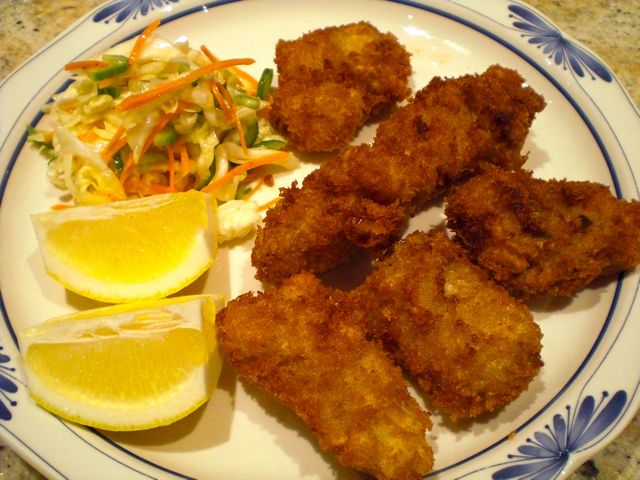
The recipe is the same as before. This time, though, because of the good quality of the oysters and the fact that I fried them perfectly (just luck). They were light and crunchy outside and juicy, soft and flavorful inside. We just enjoyed them with a squeeze of lemon and cold sake. We both thought the quantity of oysters was a bit too much for us to finish, but both of us ate everything. The side was the usual, my variation of coleslaw with honey mustard dressing.
Tuesday, April 12, 2011
Simmered "tarako" cod roe 鱈子の煮付け
This is another tarako dish which is a perfect Izakaya style drinking snack and goes perfectly with sake. I made this dish since I thawed a set of tarako roe (called "hitohara" 一腹 or "one belly" which consists of two roe sacs connected at one point). I made tarako omelet with one sac and the other sat in the fridge for two more days and needed to be quickly prepared.
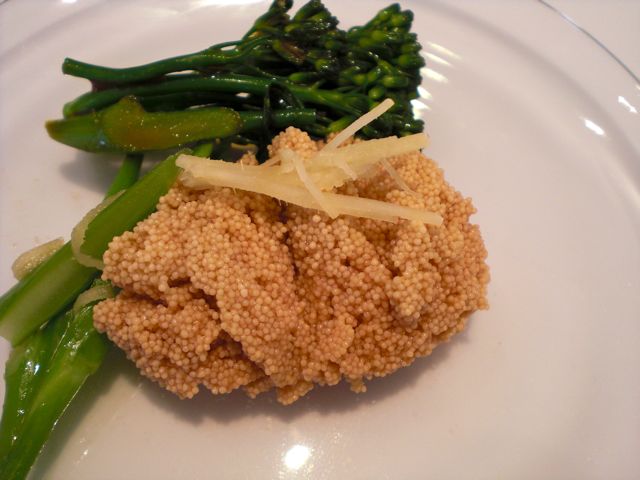
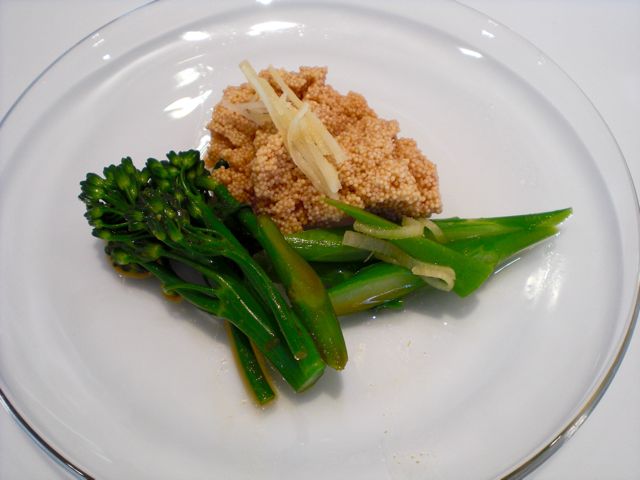 Seasoning liquid: This is a rather easy dish, especially in my case, since I had leftover broth from making "Negi-ma nabe" ねぎま鍋 the other day. I just strained the broth and adjusted the seasoning by adding sake, mirin and soy sauce. If you are making the both from scratch; dashi broth (200ml), mirin (2-3 tbs), sake (2tbs) and soy sauce (2-3 tbs) will do it. Some like it sweet and add sugar but I do not. I also add julienne of ginger root (3 thin slivers cut into fine julienne).
Seasoning liquid: This is a rather easy dish, especially in my case, since I had leftover broth from making "Negi-ma nabe" ねぎま鍋 the other day. I just strained the broth and adjusted the seasoning by adding sake, mirin and soy sauce. If you are making the both from scratch; dashi broth (200ml), mirin (2-3 tbs), sake (2tbs) and soy sauce (2-3 tbs) will do it. Some like it sweet and add sugar but I do not. I also add julienne of ginger root (3 thin slivers cut into fine julienne).
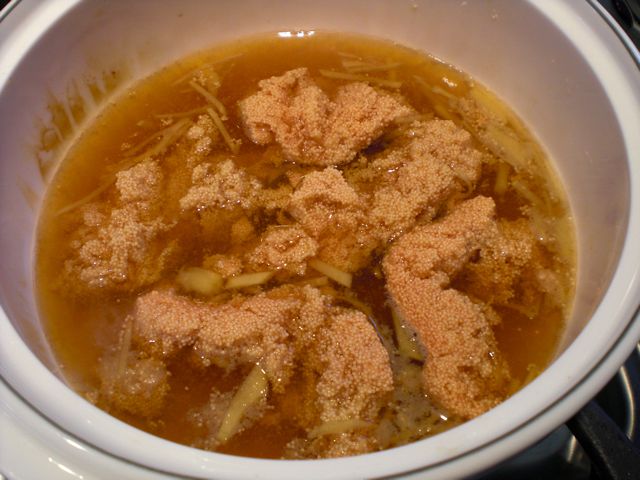 You could serve this cold, at room temperature or reheated. I served this with blanched broccolini* (which looks somewhat like Japanese mustard green or "nanohana" 菜の花 but does not taste like it) dressed with karashi-zyouyu 芥子醤油 (Japanese hot mustard, sugar, and soy sauce). For good measure, I added fresh fine julienne of ginger or hari-shouga 針ショウガ as garnish. This dish has a nice chewy and interesting texture which is quite different from uncooked tarako and rather bright ginger flavor. A really nice dish.
You could serve this cold, at room temperature or reheated. I served this with blanched broccolini* (which looks somewhat like Japanese mustard green or "nanohana" 菜の花 but does not taste like it) dressed with karashi-zyouyu 芥子醤油 (Japanese hot mustard, sugar, and soy sauce). For good measure, I added fresh fine julienne of ginger or hari-shouga 針ショウガ as garnish. This dish has a nice chewy and interesting texture which is quite different from uncooked tarako and rather bright ginger flavor. A really nice dish.
*This was developed by a Japanese seed company but is much more popular in the U.S than in Japan for some reason. If you are interested, here is a story about broccolini (in Japanese).
Tarako: Some recipes call for "raw" or unpreserved tarako. The only raw roe available around here is shad roe, which may also be used in this dish but I have not tried. So I used the usual salted tarako. It is interesting that the saltiness of the tarako reduces to the saltiness of the simmering liquid when it is cooked. So I do think either raw or salted tarako will work in this dish. I first cut one side of the membrane along the long axis and then cut it in 1 inch segments. I like this way rather than keeping a roe sac intact while cooking and then slicing it when serving. The way I prepared it made the tarako "blossom" when cooked like you see here in the picture, since the sac membrane will contract and invert the roe. This, to me, is more presentable and gives a better texture.
When the seasoning liquid came to a simmer, I added the tarako and simmered it gently for 15 minutes and let it cool to room temperature in the simmering liquid (Picture below).
*This was developed by a Japanese seed company but is much more popular in the U.S than in Japan for some reason. If you are interested, here is a story about broccolini (in Japanese).
Thursday, December 7, 2023
Electric Sake Warmer 電気酒燗器
We usually drink sake cold. For drinking sake cold, we like a crisp, clean, and fruity flavor profile of daiginjo 大吟醸. Some junmai 純米 and junmai ginjo 純米吟醸 sakes also have this flavor profile. Our house sake, curretly, is “Tengumai 50 Junmai Daiginjo” 天狗舞純米大吟醸. We enjoy it cold and it has a nice clean, dry, crisp, and fruity flavor. Now, not going into the details, somehow, by mistake (not mine), we ended up with a case of “Tengumai yamahai-shikomi junmai”天狗舞山廃仕込純米 instead of our favored house sake. As I mentioned previously this sake has a more savory, yeasty and mushroomy flavor when tasted cold or at room temperature. Then I read that this sake changes its flavor profile if heated. Almost in desperation, we tried it warm (at 120F or “Atsu-kan” 熱燗). We were pleasantly surprised that the flavor profile changed completely and became smooth and mild. We thought “Ah-Ha” the secret is that this sake should be consumed warm which would be particularly appropriate during the winter months when we have dishes like hot pot “nabe” 鍋 dishes, “sukiyaki“ すき焼き, or “oden” おでん. But the main reason we rarely drink sake warm is that one additional step of warming it up and the difficulty of maintaining the temperature while enjoying it warm. So, we decided to splurge on an electric sake warmer 電気酒燗器.
We bought it at Amazon but it came from a seller in Japan. The sake warmer sits on top of the heating unit. The server holds about 240ml (1号半). It heats up to the specified temperature in10-15 minutes. The temperature control is continuous (not discreet steps) and ranges from about 35C to 60C (95F to 140F). Using my digital thermometer and water, the actual temperatures are higher (by about 5-10F) than it indicated. We usually like “Atsu- kan” *.
*ranges of warm sake temperature
“Jouon” 常温, room temperature 20℃ (68F)
”Hinata kan” 日向燗 sunny side 30℃ (86F)
”Hitohada kan” 人肌燗 skin temperature 35℃ (95F)
”Nuru kan” ぬる燗 luke warm 40℃ (104F)
”Jou kan” 上燗 warm 45℃ (113F)
”Atsu kan” 熱燗 hot 50℃ (122F)
The sake warmer works extremely well. We can have it sitting next to us and as we are enjoying the warm sake, we can add more sake to the server. By the time we are ready for the next serving, the sake has reached the proper temperature. The only challenge is to warm up enough but not too much sake and to consume it at just the peak of time it has been warming. This is because any leftover sake once heated will not be good the next day for example. Also,warming up the sake and keeping it warm more than 1 hour is not good either. In any case, this was a great improvement break through. We are glad that we can now enjoy Tengumai junmai sake this way. So the mistake which had us end up with a case of tengumai-junmai instead of our favored house sake was indeed a “blessing in disguise”. It introduced us to a sake variation which we now enjoy but would never otherwise thought of trying.
We bought it at Amazon but it came from a seller in Japan. The sake warmer sits on top of the heating unit. The server holds about 240ml (1号半). It heats up to the specified temperature in10-15 minutes. The temperature control is continuous (not discreet steps) and ranges from about 35C to 60C (95F to 140F). Using my digital thermometer and water, the actual temperatures are higher (by about 5-10F) than it indicated. We usually like “Atsu- kan” *.
*ranges of warm sake temperature
“Jouon” 常温, room temperature 20℃ (68F)
”Hinata kan” 日向燗 sunny side 30℃ (86F)
”Hitohada kan” 人肌燗 skin temperature 35℃ (95F)
”Nuru kan” ぬる燗 luke warm 40℃ (104F)
”Jou kan” 上燗 warm 45℃ (113F)
”Atsu kan” 熱燗 hot 50℃ (122F)
The sake warmer works extremely well. We can have it sitting next to us and as we are enjoying the warm sake, we can add more sake to the server. By the time we are ready for the next serving, the sake has reached the proper temperature. The only challenge is to warm up enough but not too much sake and to consume it at just the peak of time it has been warming. This is because any leftover sake once heated will not be good the next day for example. Also,warming up the sake and keeping it warm more than 1 hour is not good either. In any case, this was a great improvement break through. We are glad that we can now enjoy Tengumai junmai sake this way. So the mistake which had us end up with a case of tengumai-junmai instead of our favored house sake was indeed a “blessing in disguise”. It introduced us to a sake variation which we now enjoy but would never otherwise thought of trying.
Thursday, January 26, 2012
Yuzu-koshou mayonnaise 柚子胡椒マヨネーズ
Yuzu-koshou 柚子胡椒 is one of the most useful and versatile Japanese condiment/seasonings. It is a mixture of salt, chopped peel of a Japanese citrus called "yuzu" 柚子 and chili pepper (usually green chili pepper but it could also be red chili pepper). Chili peppers are called "koshou" in Kyushu Island 九州. In the rest of Japan, "koshou" usually means either ground black or white peppercorns and chili peppers are called "Tougarashi" 唐辛子. One could make this from scratch if yuzu is available but, yuzu, even if available, in the U.S. is too expensive to attempt this.
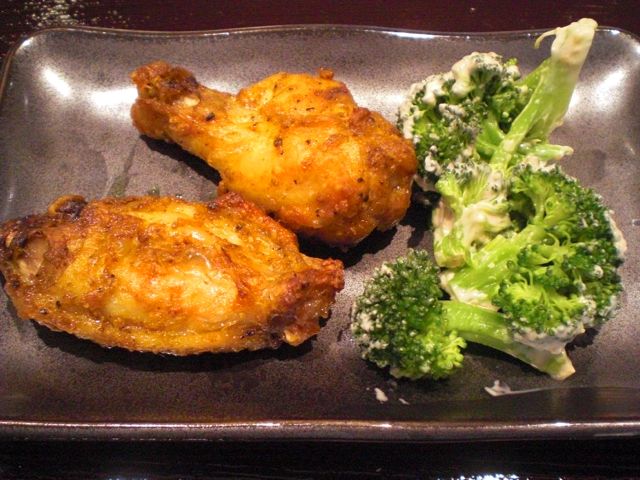 The mixture of yuzu flavor and spiciness really adds even to store-bought mayonnaise.
The mixture of yuzu flavor and spiciness really adds even to store-bought mayonnaise.
The next best thing is to buy ready-made yuzu-koshou in a tube as seen in the left. This will keep at least a few weeks or more in the refrigerator after opening. Yuzu-koshou is usually used as a seasoning or condiment for Nabe dishes, noodles in broth, and cold cubes of tofu but it could be used in any dish. I use it to season meat mixtures for hamburgers or Japanese "Tsukune" dishes.
Another way to use yuzu-koshou is as a dressing. The easiest combination is to mixed it with mayonnaise. Like wasabi-mayonnaise, you could add quite a bit of yuzu-koshou, since the mayonnaise dampens the heat. I usually make it with a ratio of almost 1:1 of mayo and yuzu-kosho but this is totally up to your taste. You could also add soy sauce in addition.
Here are two examples of how I used yuzu-koshou-mayonnaise.
The first one below is steamed haricot verts dressed in mayo-yuzu-koshou. This was served as a side for Paprika-cumin rubbed low-temperature (350F) baked pork tenderloin slices, homemade cranberry sauce, my wife's mushed potato seasoned with soy sauce and butter.
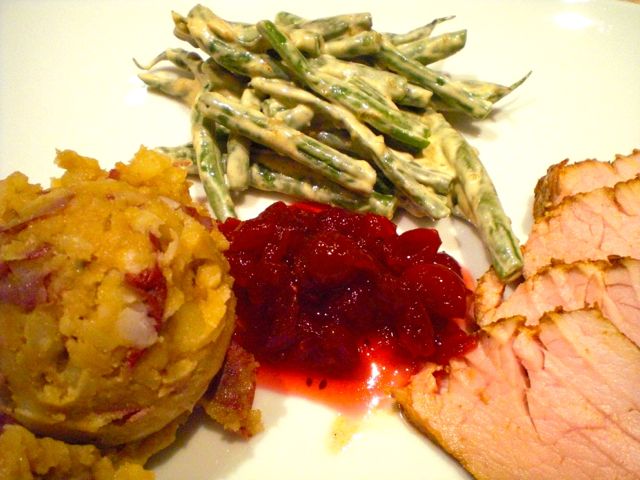 On another occasion, I served curry flavored chicken wing and drumet with steamed broccoli dressed in yuzu-koshou-mayo.
On another occasion, I served curry flavored chicken wing and drumet with steamed broccoli dressed in yuzu-koshou-mayo.
Here are two examples of how I used yuzu-koshou-mayonnaise.
The first one below is steamed haricot verts dressed in mayo-yuzu-koshou. This was served as a side for Paprika-cumin rubbed low-temperature (350F) baked pork tenderloin slices, homemade cranberry sauce, my wife's mushed potato seasoned with soy sauce and butter.
Sunday, December 29, 2019
Grilled feta, olive and grapes
My wife found this recipe in the food section of the Washington Post. It's a rather simple dish but we really like it. It makes a good appetizer and goes well with wine. We served it with mini-baguette.
The original recipe suggested cooking this in a cast iron skillet. We thought that might be too big for the quantity we wanted to make so we cooked this is a small anodized cast aluminum pan (this was a Japanese style pot (mini version) with a wooded lid for an individual "nabe" dish) which worked perfectly.
The cubes of feta cheese get brown and crispy on the outside but soft inside. My wife thought it is also good just to enjoy without bread. The combination of spices (fennel seeds, red pepper flakes and ground black pepper), salty olives and sweet grapes all worked well.
Ingredients:
1 tablespoon extra-virgin olive oil, plus more as needed
1/2 cup (2 3/4 ounces) seedless red grapes, (we cut the amount in half).
1/3 cup (1 1/2 ounces) pitted and halved Kalamata olives. (We used a combination of the different olives we had on hand. We cut some of the large ones in half.)
1/2 teaspoon fennel seeds, crushed
1/2 teaspoon crushed red pepper flakes
Freshly ground black pepper
8 to 10 ounces feta cheese (in a block)
Good, crusty bread slices, for serving
Directions:
Preheat the oven to 425 degrees with the rack in the middle (we used our toaster oven on convection mode on the bottom rack). Oil a small, oven-proof casserole dish or cast-iron pan. Add the grapes, olives, 1 tablespoon olive oil, fennel seeds, red pepper flakes and a few grinds of black pepper, and stir to combine.
Break the block of feta up into irregular pieces, then nestle them among the grapes and olives. Drizzle with more olive oil, then bake, 20 to 25 minutes, until the grapes are softened and the feta is browned in spots.
This is a really good dish. We had only a small portion the night we made it and reheated it later in the microwave which worked well. My wife kept reminding me as I made the dish, "a little bit of fennel goes a long way". Don't over do it' the fennel actually made the dish. The combination of fennel, olives and grapes were made for each other and the total went remarkably well with red wine. Definitely this will join to our line up of "regular" dishes.
The original recipe suggested cooking this in a cast iron skillet. We thought that might be too big for the quantity we wanted to make so we cooked this is a small anodized cast aluminum pan (this was a Japanese style pot (mini version) with a wooded lid for an individual "nabe" dish) which worked perfectly.
The cubes of feta cheese get brown and crispy on the outside but soft inside. My wife thought it is also good just to enjoy without bread. The combination of spices (fennel seeds, red pepper flakes and ground black pepper), salty olives and sweet grapes all worked well.
Ingredients:
1 tablespoon extra-virgin olive oil, plus more as needed
1/2 cup (2 3/4 ounces) seedless red grapes, (we cut the amount in half).
1/3 cup (1 1/2 ounces) pitted and halved Kalamata olives. (We used a combination of the different olives we had on hand. We cut some of the large ones in half.)
1/2 teaspoon fennel seeds, crushed
1/2 teaspoon crushed red pepper flakes
Freshly ground black pepper
8 to 10 ounces feta cheese (in a block)
Good, crusty bread slices, for serving
Directions:
Preheat the oven to 425 degrees with the rack in the middle (we used our toaster oven on convection mode on the bottom rack). Oil a small, oven-proof casserole dish or cast-iron pan. Add the grapes, olives, 1 tablespoon olive oil, fennel seeds, red pepper flakes and a few grinds of black pepper, and stir to combine.
Break the block of feta up into irregular pieces, then nestle them among the grapes and olives. Drizzle with more olive oil, then bake, 20 to 25 minutes, until the grapes are softened and the feta is browned in spots.
This is a really good dish. We had only a small portion the night we made it and reheated it later in the microwave which worked well. My wife kept reminding me as I made the dish, "a little bit of fennel goes a long way". Don't over do it' the fennel actually made the dish. The combination of fennel, olives and grapes were made for each other and the total went remarkably well with red wine. Definitely this will join to our line up of "regular" dishes.
Tuesday, February 21, 2012
Cellophane noodle, chicken skin and cucumber salad 春雨と雛皮の和え物
This was a small starter dish one evening. Again, I used what I had at hand to make this simple but tasty dish. The only item I cooked specifically for this dish was the cellophane noodle or "harusame" 春雨. This means "spring rain" which is a poetic name for Japanese-style cellophane noodles. Although this noodle is originally Chinese, the Japanese version is made from potatoes and corn starch (instead of mung bean startch). The other ingredient in the salad was the microwave "sakamushi" chicken which I made the day before. The blanched bean sprout was leftover from making the "kinchaku" oden dish.
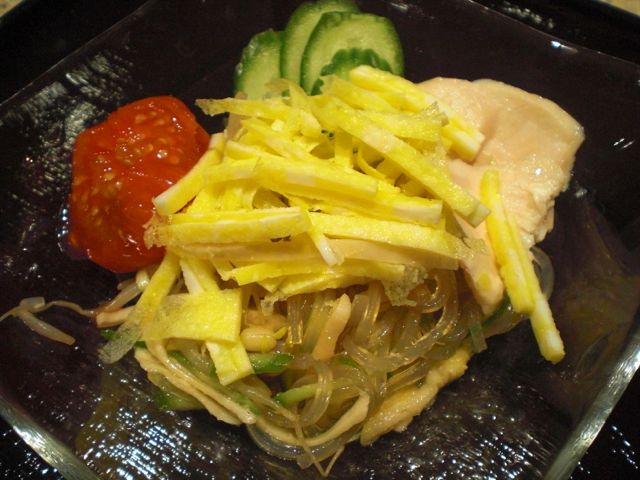
Noodle: On the left is a package of "harusame" noodle. It is dried and comes as brittle white straight noodles but once it is cooked, it becomes semi-transparent noodle with a unique texture--somewhat slippery, soft yet al dente. (The package touts "mochi mochi" mouthfeel). This noodle can be used in soup, nabe, or braised or stir-fried dish. The initial cooking needs to be adjusted depending on how you use it. In my case, I used it in a salad. So, I cooked it fully (about 7 minutes) in boiling water. I drained and washed the noodles immediately in cold running water. I cut the noodles into three segments for the ease of eating. The amount of noodle is totally arbitrary but I used 1/4 of the package. When cooked, the volume of the noodle increases about 4-5 fold.
Cucumber: I washed, salt-rubbed, washed again one American mini-cucumber and sliced it on a slant thinly first. I then julienned it. I salted, kneaded and squeezed out the excess moisture.
Bean sprout: Mung bean sprouts blanched which was leftover from making "kinchaku" oden item. I had about 1/2 cup.
Golden thread egg: This is an extra but I decided to make "kinshiran" 金糸卵. I used one egg beaten and seasoned with salt. I made a very thin omelet by cooking it on a very low flame using a non-stick frying pan coated with a small amount of vegetable oil and with the lid on. After it finished cooking, I cut it into 4 strips and then julienned.
This is a perfect small Izakaya dish to start. You could used chile oil instead of tabasco and sesame oil but this combination is one I always use in leu of chile oil. The combination of the noodle and bean sprout created very good textures and the chicken skin added favor. For instant dressing, the subtle heat from Tabasco and sesame flavor are excellent.
The amounts are all arbitrary but we had about 4 servings of the salad by the time I finished it (small servings as seen above).
Noodle: On the left is a package of "harusame" noodle. It is dried and comes as brittle white straight noodles but once it is cooked, it becomes semi-transparent noodle with a unique texture--somewhat slippery, soft yet al dente. (The package touts "mochi mochi" mouthfeel). This noodle can be used in soup, nabe, or braised or stir-fried dish. The initial cooking needs to be adjusted depending on how you use it. In my case, I used it in a salad. So, I cooked it fully (about 7 minutes) in boiling water. I drained and washed the noodles immediately in cold running water. I cut the noodles into three segments for the ease of eating. The amount of noodle is totally arbitrary but I used 1/4 of the package. When cooked, the volume of the noodle increases about 4-5 fold.
The sakamushi or sake-steamed chicken: I removed the skin of one breast and thinly sliced. I also sliced the meat (3 slices per serving).
Cucumber: I washed, salt-rubbed, washed again one American mini-cucumber and sliced it on a slant thinly first. I then julienned it. I salted, kneaded and squeezed out the excess moisture.
Bean sprout: Mung bean sprouts blanched which was leftover from making "kinchaku" oden item. I had about 1/2 cup.
Golden thread egg: This is an extra but I decided to make "kinshiran" 金糸卵. I used one egg beaten and seasoned with salt. I made a very thin omelet by cooking it on a very low flame using a non-stick frying pan coated with a small amount of vegetable oil and with the lid on. After it finished cooking, I cut it into 4 strips and then julienned.
Dressing: This is an instant dressing made of ponzu souyu ポン酢醤油 (from the bottle, about 3 tbs), dark sesame oil (about 1 tsp), and tabasco (to taste).
I dressed everything except for the golden thread egg. I put the cucumber and chicken slices in a shallow bowl and served the salad in the middle and garnished it with the golden thread egg.
This is a perfect small Izakaya dish to start. You could used chile oil instead of tabasco and sesame oil but this combination is one I always use in leu of chile oil. The combination of the noodle and bean sprout created very good textures and the chicken skin added favor. For instant dressing, the subtle heat from Tabasco and sesame flavor are excellent.
Subscribe to:
Posts (Atom)






